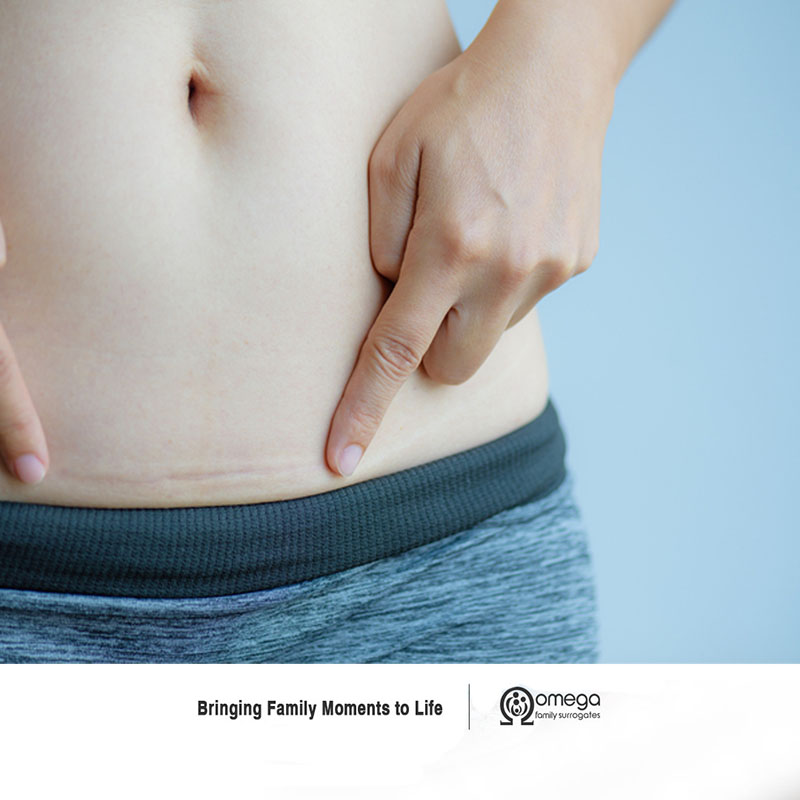C is for Caedere
The C in C-section stands for cut. In Latin the word for cut is Caedere. This makes perfect sense since the mother is cut to bring out the child. This is where it gets interesting: there are legends that claim Julius Caesar, the Roman Emperor, was born this way, hence the name. This myth was soon debunked because according to Roman law, cutting the mother was only allowed if she was dead and the baby could be saved. Caesar’s mother lived for a very long time.
How many C-sections can a woman have prior her Surrogacy Journey?
When a woman is considering Surrogacy to help a couple complete their family, one of the requirements is the number of previous C-sections allowed. Omega Family Surrogates is a Surrogacy Agency that places the Surrogates’ well-being as a top priority, therefore they pay close attention to what Invitro Fertilization Clinics (IVF clinics) say about this topic. Most of the IVF clinics state that a woman may not have had more than 2 C-sections prior to applying to become a Surrogate. The Surrogacy pregnancy can be her 3rd C-section but it cannot be her 4th. This is to keep the Surrogate and the baby safer. These requirements change as the IVF clinics acquire more experience and technology advances. It is always safer to ask the Surrogacy Agency or the doctor about what is recommended. At this moment, the information provided is what is permitted.
How do you know if you will need a c-section or not?
When a woman becomes pregnant she cannot know whether the doctor will or will not require her to undergo a C-section surgery. It is only based on experience or a specific physical predicament that a medical professional or the woman herself will know if she has the need of a C-section or not. This is why it is so important that a potential Surrogate be a mother herself, because this is how she knows if she is prone or not prone to a non-vaginal birth.
How many pregnancies can a woman have already had prior to becoming a Surrogate?
Omega Family Surrogates has a set of requirements that have been established with the Invitro Fertilization (IVF) Clinics, to make the Surrogacy Journey safe. One of these requirements is the amount of C-sections she is allowed to have prior to becoming a Surrogate as well as how many prior pregnancies she has had. Many staff members are mothers themselves, some having been Gestational Surrogates. After years of research, conversations with IVF clinics and practical knowledge in the field of Surrogacy, Omega Family Surrogates has determined that a woman must not have had over 6 pregnancies. Experience indicates that at this number the woman can have a healthy pregnancy and deliver safely. Regarding C-sections, it is agreed that the Surrogate Pregnancy Delivery can be either the 1st, 2nd or 3rd C-section for a Gestational Carrier. If the Surrogacy Pregnancy could lead to a fourth C-section, the woman would not be allowed to serve as an Omega Surrogate, to ensure the safety of not only the Gestational Carrier, but the baby as well.
Benefits of a c-section:
1. Knowing when the baby is to be born.
One benefit of undergoing a C-section is knowing exactly when it is going to occur. That way you can plan accordingly. Everything you need to have done, and all those people who you want to be with you can coordinate their plans around when the baby is to be born. This is also true for women who are professionals and must delegate and plan how their responsibilities will be taken care of at work during their absence. If the Surrogate knows when she will have the surgery, she can schedule and train someone to take her place at work, to make sure that what she is in charge of will still get done while she is on maternity leave.
2. How long the procedure is going to take.
Secondly, with a C-section the Surrogate and the Intended Parents know how long the wait will be to see baby come into the world. A vaginal delivery could, either be very quick or take hours. According to the American College of Obstetrics and Gynecology a C-section takes 5-10 min to remove the baby, and 45 minutes to close the incision.
A c-section is abdominal surgery
“Women really need to understand that a C-section is major abdominal surgery,” says Jan Kriebs, a certified nurse mid-wife in the University of Maryland Medical Center’s obstetrics. Many times C-sections are not considered surgeries, but just another way of giving birth. This should not be taken lightly; a C-section is surgery, and once that reality is well understood and evaluated, the Surrogate can make an informed decision. Surgery requires more healing time than a vaginal delivery and may lead to complications. As a Gestational Surrogate, you want to return home in the best condition possible to return to your family and normal activities.
How do you know if you will need a c-section?
If need be, an Omega Family Surrogate will deliver through C-section. To determine if a woman will undergo a C-section, there are many circumstances that must be taken into account. First of all, her own particular birthing history is evaluated. If a woman has not had a C-section before, there is a low percentage that she will deliver in this manner. On the other hand, if the Surrogate has had prior C-sections, there is a 98% chance that this will be the way that the baby is born. Another circumstance that must be considered is if the Surrogate is going to give birth to multiple babies. More often than not, multiple births do require a C-section for the babies’ safety as well as that of the Gestational Carrier.
A C-section is an option for a Surrogate mother to deliver the Intended Parents’ baby and to fulfill her purpose of providing family moments that the IPs would not have if it were not for her. It is important to note that no matter what the GC decides to do in combination with her doctors and her family, her choice should be the safest and most convenient for her health and the baby’s.
Omega Family Surrogates, Bringing Family Moments to Life in the safest and amazing way possible.






